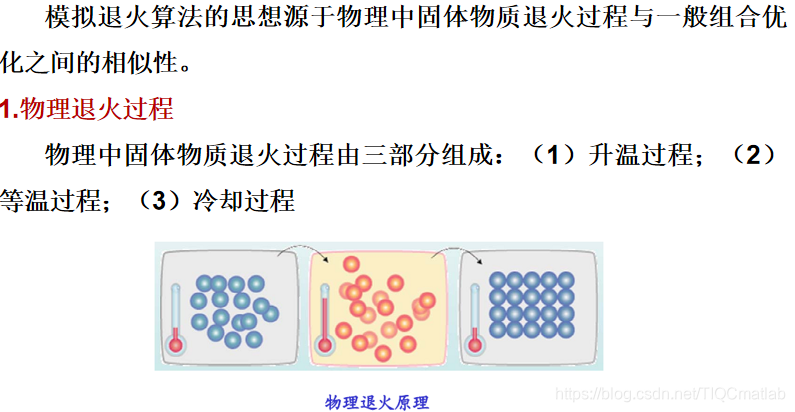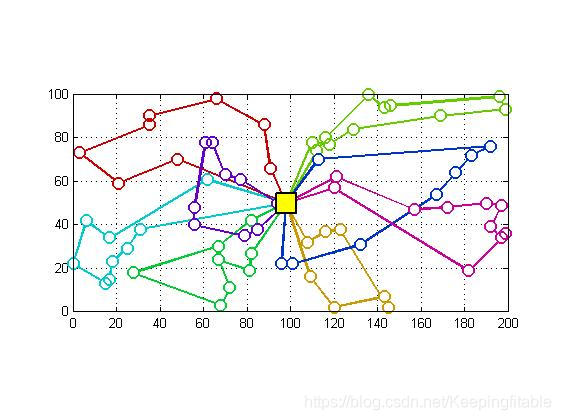【VRP】基于matlab模拟退火算法求解带容量的VRP问题(多种容量)【含Matlab源码 001期】
本文共 3699 字,大约阅读时间需要 12 分钟。
一、简介
模拟退火算法介绍



 3 模拟退火算法的参数 模拟退火是一种优化算法,它本身是不能独立存在的,需要有一个应用场合,其中温度就是模拟退火需要优化的参数,如果它应用到了聚类分析中,那么就是说聚类分析中有某个或者某几个参数需要优化,而这个参数,或者参数集就是温度所代表的。它可以是某项指标,某项关联度,某个距离等等。
3 模拟退火算法的参数 模拟退火是一种优化算法,它本身是不能独立存在的,需要有一个应用场合,其中温度就是模拟退火需要优化的参数,如果它应用到了聚类分析中,那么就是说聚类分析中有某个或者某几个参数需要优化,而这个参数,或者参数集就是温度所代表的。它可以是某项指标,某项关联度,某个距离等等。 二、源代码
%%clc;clear;close all;%% Problem Definitionmodel=SelectModel(); % Select Model of the Problemmodel.eta=0.1;CostFunction=@(q) MyCost(q,model); % Cost Function%% SA ParametersMaxIt=500; % Maximum Number of IterationsMaxIt2=80; % Maximum Number of Inner IterationsT0=100; % Initial Temperaturealpha=0.98; % Temperature Damping Rate%% Initialization% Create Initial Solutionx.Position=CreateRandomSolution(model);[x.Cost, x.Sol]=CostFunction(x.Position);% Update Best Solution Ever FoundBestSol=x;% Array to Hold Best Cost ValuesBestCost=zeros(MaxIt,1);% Set Initial TemperatureT=T0;%% SA Main Loopfor it=1:MaxIt for it2=1:MaxIt2 % Create Neighbor xnew.Position=CreateNeighbor(x.Position); [xnew.Cost, xnew.Sol]=CostFunction(xnew.Position); if xnew.Cost<=x.Cost % xnew is better, so it is accepted x=xnew; else % xnew is not better, so it is accepted conditionally delta=xnew.Cost-x.Cost; p=exp(-delta/T); if rand<=p x=xnew; end end % Update Best Solution if x.Cost<=BestSol.Cost BestSol=x; end end % Store Best Cost BestCost(it)=BestSol.Cost; % Display Iteration Information if BestSol.Sol.IsFeasible FLAG=' *'; else FLAG=''; end disp(['Iteration ' num2str(it) ': Best Cost = ' num2str(BestCost(it)) FLAG]); % Reduce Temperature T=alpha*T; % Plot Solution figure(1); PlotSolution(BestSol.Sol,model); pause(0.01); end% function model=CreateRandomModel(I,J) rmin=10; rmax=25; r=randi([rmin rmax],1,I); TotalDemand=sum(r); cmean=TotalDemand/J; cmin=round(cmean); cmax=round(1.25*cmean); c=randi([cmin cmax],1,J); xmin=0; xmax=200; ymin=0; ymax=100; x=randi([xmin xmax],1,I); y=randi([ymin ymax],1,I); alpha_x=0.1; xm=(xmin+xmax)/2; dx=xmax-xmin; x0min=round(xm-alpha_x*dx); x0max=round(xm+alpha_x*dx); alpha_y=0.1; ym=(ymin+ymax)/2; dy=ymax-ymin; y0min=round(ym-alpha_y*dy); y0max=round(ym+alpha_y*dy); x0=randi([x0min x0max]); y0=randi([y0min y0max]); d=zeros(I,I); d0=zeros(1,I); for i=1:I for i2=i+1:I d(i,i2)=sqrt((x(i)-x(i2))^2+(y(i)-y(i2))^2); d(i2,i)=d(i,i2); end d0(i)=sqrt((x(i)-x0)^2+(y(i)-y0)^2); end eta=0.5; model.I=I; model.J=J; model.r=r; model.c=c; model.xmin=xmin; model.xmax=xmax; model.ymin=ymin; model.ymax=ymax; model.x=x; model.y=y; model.x0=x0; model.y0=y0; model.d=d; model.d0=d0; model.eta=eta;end%function qnew=CreateNeighbor(q) m=randi([1 3]); switch m case 1 % Do Swap qnew=Swap(q); case 2 % Do Reversion qnew=Reversion(q); case 3 % Do Insertion qnew=Insertion(q); endendfunction qnew=Swap(q) n=numel(q); i=randsample(n,2); i1=i(1); i2=i(2); qnew=q; qnew([i1 i2])=q([i2 i1]); endfunction qnew=Reversion(q) n=numel(q); i=randsample(n,2); i1=min(i(1),i(2)); i2=max(i(1),i(2)); qnew=q; qnew(i1:i2)=q(i2:-1:i1);endfunction qnew=Insertion(q) n=numel(q); i=randsample(n,2); i1=i(1); i2=i(2); if i1
三、运行结果



四、备注
版本:2014a
完整代码或代写添加QQ 1564658423转载地址:http://veaez.baihongyu.com/
你可能感兴趣的文章